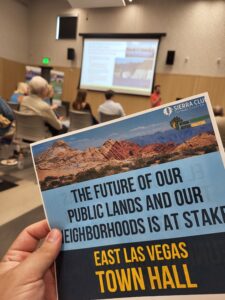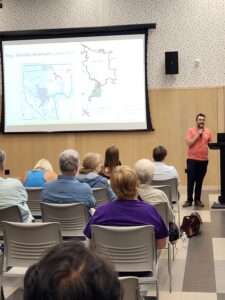
‘As the town hall closed, the speakers took questions from the audience and ended with a call to action for the communities of Las Vegas. They called for the public to call their elected officials, and voice support against Las Vegas sprawl and for the alternatives like public transit and infill.’
LAS VEGAS — In an East Las Vegas library in the middle of May, representatives of two local organizations gathered members of the community to inform them that their federal representatives are planning to sell and develop more of Nevada’s public lands.
The Sierra Club Toiyabe Chapter and Nevada Environmental Justice Coalition organized the May 17 town hall to let local residents know about their elected officials’ multiple plans to open up Southern Nevada federal lands for development.
Different plans introduced by both Nevada’s Democratic federal officials and its lone Republican congressman proposed increasing the urban sprawl of Las Vegas, stretching as far as the nearby town of Jean, just over 30 miles away.
‘Sell off more than 100,000 acres of Nevada’s land to help balance the budget’
Nevada’s Republican US Representative Mark Amodei proposed an amendment to Trump’s proposed budget on May 7, which would’ve opened up over 400,000 acres of Nevada public lands for sale, according to the town hall speakers and multiple news sources. He introduced this amendment after 11 pm, to the outrage of congressional Democrats, including Amodei’s Democratic colleagues that also represent Nevada.
The majority of land freed up for sale in Amodei’s amendment would’ve been within his own jurisdiction, but the proposal also called to sell over 100,000 acres in Clark County, which includes Las Vegas, as well as nearby Nye County, whose nearest town of Pahrump is 60 miles from Las Vegas. Both counties lie outside of Amodei’s congressional district.
“What it proposed to do was sell off more than 100,000 acres of Nevada’s land to help balance the budget,” Sierra Club Toiyabe Chapter Volunteer Chair Vinny Spotleson said at the town hall. “This was without the consent of the other congressional members and without the local governments.”
Amodei’s middle-of-the-night budget amendment failed and was removed from the Republicans’ federal budget on May 21, thanks to the efforts of Nevada Democrats and Minnesota representative Ryan Zinke.
But another plan put forward by Nevada’s Democratic federal officials would also allow Las Vegas to sprawl out to Jean, and is still making its way through Congress.
‘The part we’re very concerned about is the sprawl’

Nevada US Senator Catherine Cortez Masto reintroduced her Southern Nevada Economic Development and Conservation Act to the Senate in March, after it passed committee last year. The act, which Cortez Masto created with Nevada US Representative Susie Lee, would protect over 2 million acres of habitat conservation, outdoor recreation, and cultural and landscape preservation according to Cortez Masto’s announcement of reintroducing the bill on her website.
But even though the Democrats’ plan included land protections, it still significantly increases Las Vegas urban sprawl.
“It does include a lot of conservation that we like,” Spotleson said, “but the part we’re very concerned about is the sprawl.”
The congresswoman’s website also said the bill would open up to 25,000 acres in Clark County for development within 5 years of its passing.
A map shown at the May 17 town hall showed that the plans for that development would allow Las Vegas sprawl to reach Jean, like Amodei’s plan, and also open up pockets of land for development in the northwestern Las Vegas Valley near Red Rock, southeastern Las Vegas boundary, and eastern Las Vegas boundary.
Politicians backed by the real estate industry
All the Congress members for Nevada that proposed increasing urban sprawl in the Las Vegas Valley received campaign finance donations from companies involved in real estate and construction according to opensecrets.org and Quiver Quantitative.
Opensecrets is a nonprofit organization that gathers campaign finance data on politicians to track who is funding their campaigns, and Quiver Quantitative is an investment research platform that tracks what companies donate to political campaigns and which politicians own and trade stock, among other functions.
Mark Amodei’s campaign in 2024 received tens of thousands from realtors, home builders, and corporations involved in those industries according to opensecrets and Quiver Quantitative.
Opensecrets reported that the Republican representative took $19,800 from the Meruelo Group, a conglomerate which has holdings in construction and real estate according to its website, $10,000 from the National Association of Realtors, $9,900 from Di Loreto Homes of Nevada, a homebuilder based in Reno, and $8,500 from the National Association of Homebuilders.
According to Quiver Quantitative, since 2017 Amodei also received $10,000 from the political action committee for Blackrock, a massive corporation with holdings in real estate and construction, and $5,500 from MDU Resources, a construction company focused on delivering and servicing utilities.
Catherine Cortez Masto’s campaigns since 2019 also accepted money from companies involved in real estate and construction according to opensecrets and Quiver Quantitative.
Opensecrets reports that Cortez Masto received $57,550 from Blackstone Group, an investment firm with holdings in real estate, and $48,500 from Apollo Global Management, an asset management firm with holdings in real estate since 2019.
According to Quiver Quantitative, Cortez Masto received a total of $10,000 from Blackrock, $5,000 from Invesco, an investment management firm with holdings in real estate, and $2,500 from Goldman Sachs, an international investment bank with holdings also with holdings in real estate, among others.
Like her colleagues, Susie Lee’s campaign for her House of Representatives seat also accepted tens of thousands of dollars in campaign finance donations from companies involved in real estate and construction, according to opensecrets and Quiver Quantitative.
Lee took $23,104 from Bain Capital, a private investment firm with holdings in real estate, $22,800 from Apollo Global Management, and $13,716 from Goldman Sachs, among others according to opensecrets.
Quiver Quantitative reports since 2017, Lee’s campaigns also took $5,000 from AMH, a property management company that rents out multiple homes in the Las Vegas Valley, $2,500 from Quanta Services, a construction company that specializes in utility infrastructure, among others.
Unlike her colleagues Amodei and Cortez Masto, Lee also traded millions of dollars worth of stock according to Quiver Quantitative, with a trade volume of over $10 million since 2019. Her stock trading includes a sale of stock in Cushman & Wakefield, a commercial real estate company in Las Vegas, alongside multiple stock transactions involving resort corporations that have properties in the Las Vegas Valley.
Both opensecrets and Quiver Quantitative report that Amodei, Lee, and Cortez Masto all also took campaign money from multiple hotel chains with properties in Las Vegas, financial corporations, banks, and energy companies among others.
‘This would turn buildings into ovens and streets into skillets’
Urban sprawl is the uncontrolled expansion outward of urban areas, it is what made Las Vegas grow outward from its original city center.
Spotleson and other speakers at the town hall explained that plans to increase urban sprawl ultimately harm the public on multiple fronts: They said urban sprawl causes more traffic, worsens air quality, exasperates the urban heat island effect, destroys natural ecosystems, and drives climate change, among other negatives.
Spotleson said that urban sprawl makes traffic worse by bringing more people to the Las Vegas valley, and forces the newcomers to travel longer distances to access the resources in the city, especially if minimal improvements are made to public transit infrastructure.
That higher volume of cars needing to travel longer distances and spending more time on the road also would produce more carbon emissions, which would help exacerbate climate change and worsen air quality.
“One of my students recently completed a project showing that across Las Vegas the existing sprawl has contributed to more pollution and longer commute times immeasurably for everyone, but in particular for vulnerable populations,” UNLV Assistant Professor of Public Policy Ben Leffel said at the town hall.
The development that creates urban sprawl inherently destroys natural ecosystems through its construction, and both Leffel and Spotleson said the removal of those ecosystems worsen issues like climate change and the urban heat island effect.
The urban heat island effect is a phenomenon where developed areas and urban centers have higher temperatures than nearby rural or natural areas, due to the lack of vegetation and surfaces that better absorb heat.
“If we develop out to Primm and Jean we’re going to pave over existing natural systems that allow us to fight urban heat island,” Leffel said. “And it’s more difficult across spread out areas to provide tree cover and canopy cover, we would lack those protections. This would turn buildings into ovens and streets into skillets.”
Nevada Plants, a local nonprofit focused on advocacy and education centered around the benefits of planting trees and other plants, reported that Las Vegas is among the most extreme urban heat islands in the US. The organization reported that the Las Vegas city center is 7 degrees hotter than surrounding rural areas, and that difference can get as high as 24 degrees hotter.
A study published by UNLV in 2020 ranked Las Vegas as the most extreme urban heat island in the US and the fastest-warming city in the country.
The extreme heat in Las Vegas, which is made worse by the urban heat island effect, contributed to the deaths of over 500 people in 2024. Local news outlets reported in February that 526 suffered heat-related deaths last year according to the Clark County coroner.
‘The solution here is to build smarter’
The Sierra Club and Nevada Environmental Justice Coalition did not just rail against urban sprawl, they also put forward alternative solutions to allow more development and to address already existing issues that would be made worse by more outward development.
“The solution here is to build smarter,” Leffel said. “It’s to build up not out.”
Speakers called for Las Vegas to instead focus on infill development, which means to develop and redevelop land in spaces that already exist within existing urban centers. Spaces used for infill development could include vacant lots, undeveloped lots, empty parking lots, etc.
A study done by the Regional Transport Commission in Southern Nevada found that there are over 70,000 acres already within the Las Vegas urban center that could be used for infill development.
Speakers at the town hall also called for improvements to public transit, including construction of a light rail in Southern Nevada, to improve on issues from the already existing Las Vegas sprawl.
The organizations proposed that the government can pay for construction of a light rail through multiple means, including increasing taxes on private jets, a transit fee for uber or lyft, a state constitution change to let gas taxes be used on transit, or a progressive tax on electric vehicles.
As the town hall closed, the speakers took questions from the audience and ended with a call to action for the communities of Las Vegas. They called for the public to call their elected officials, and voice support against Las Vegas sprawl and for the alternatives like public transit and infill.
“Our voices matter, and the other party, they are calling and they are leaving their voices, and we need our voices to be louder,” Nevada resident Trish Harrison said at the town hall. “If you’re anything like me, you’re a little fatigued, you’ve been calling and you’re just tired. Keep calling. Keep the pressure on. It does matter.”
The Sierra Club Toiyabe Chapter and Nevada Environmental Justice Coalition plan on more town halls like the one in East Las Vegas across the valley and in Northern Nevada. Information on the town halls can be found on the Sierra Club Toiyabe Chapter website.
Mark Credico is an independent journalist working in Southern Nevada. He covers subjects including government accountability, homelessness, workers' unions and the environment.

